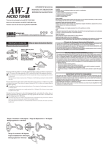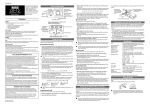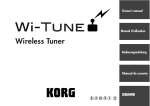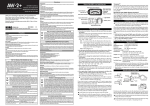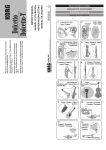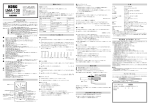Download owner's manual manuel d'utilisation bedienungsanleitung
Transcript
OWNER’S MANUAL MANUEL D’UTILISATION BEDIENUNGSANLEITUNG 取扱説明書 Thank you for purchasing the Korg MICRO TUNER AW-1. Merci d’avoir fait l’acquisition du MICRO TUNER AW-1 Korg. Herzlichen Dank für den Kauf des Korg MICRO TUNER AW-1. このたびはコルグ MICRO TUNER AW-1 をお買い上げいただき、ありがとうございます。 Precautions Location Using the unit in the following locations can result in a malfunction. • In direct sunlight • Locations of extreme temperature or humidity • Excessively dusty or dirty locations • Locations of excessive vibration • Close to magnetic fields Power supply Be sure to turn the power switch to OFF when the unit is not in use. Remove the battery in order to prevent it from leaking when the unit is not in use for extended periods. Interference with other electrical devices Radios and televisions placed nearby may experience reception interference. Operate this unit at a suitable distance from radios and televisions. Handling To avoid breakage, do not apply excessive force to the switches or controls. Care If the exterior becomes dirty, wipe it with a clean, dry cloth. Do not use liquid cleaners such as benzene or thinner, or cleaning compounds or flammable polishes. 15-12, Shimotakaido 1-chome, Suginami-ku, Tokyo, Japan C 2004 KORG INC. Keep this manual After reading this manual, please keep it for later reference. Keeping foreign matter out of your equipment Never set any container with liquid in it near this equipment. If liquid gets into the equipment, it could cause a breakdown, fire, or electrical shock. Be careful not to let metal objects get into the equipment. Attaching the included clip Mise en place de la pince fournie Anbringen des mitgelieferten Clips 付属クリップの取付け OK Attach / Mise en place Anbringen NG Remove / Retrait Meter surface Abnehmen Surface de l'accordeur Messgerätoberfläche Firmly push the clip all the way into the attachment slot, making sure that it's oriented correctly. To remove the clip, grasp the AW-1 and pull the clip in the opposite direction. Do not attempt to insert anything other than the included clip. Doing so may damage the connector or other parts. The large clip can rotate a maximum of +/-90 degrees. It will break if you attempt to rotate it farther than this. Poussez fermement la pince dans la fente de fixation jusqu'au bout, en veillant à ce qu'elle soit dans le bon sens. Pour enlever la pince, Saisissez le AW-1 et tirez sur la pince dans la direction opposée. N'essayez pas d'insérer autre chose que la pince fournie. Vous risqueriez d'endommager le connecteur ou d'autres pièces. La grande pince peut pivoter sur un angle maximal de +/- 90 degrés. Elle se brisera si vous essayez de la faire tourner plus. Drücken Sie den Clip ganz in den Anbringungsschacht, und stellen Sie sicher, dass er richtig ausgerichtet ist. Zum Abnehmen des Clips greifen Sie den AW-1 und ziehen den Clip in entgegengesetzter Richtung. Versuchen Sie nicht, einen anderen Gegenstand als den mitgelieferten Clip einzusetzen. Dadurch können die Steckverbindung oder andere Teile beschädigt werden. Der große Clip kann maximal um +/-90 Grad drehen. Wenn Sie versuchen, ihn weiter zu drehen, bricht er ab. クリップ取付溝に方向を間違わないように、強く押して奥まで差し込んでください。 外すときは、本体を押さえながら、付属クリップを反対方向に引っ張ります。 付属のクリップ以外は差し込まないでください。本体の端子等を破損する恐れが あります。 クリップ大の可動範囲は±90度です。それ以上無理に回すとクリップを破損します。 ! 可動範囲±90° ! 可動範囲180° CE mark for European Harmonized Standards CE mark which is attached to our company’s products of AC mains operated apparatus until December 31, 1996 means it conforms to EMC Directive (89/336/EEC) and CE mark Directive (93/68/EEC). And, CE mark which is attached after January 1, 1997 means it conforms to EMC Directive (89/336/EEC), CE mark Directive (93/68/EEC) and Low Voltage Directive (73/23/EEC). Also, CE mark which is attached to our company’s products of Battery operated apparatus means it conforms to EMC Directive (89/336/EEC) and CE mark Directive (93/68/EEC). THE FCC REGULATION WARNING (for U.S.A.) This equipment has been tested and found to comply with the limits for a Class B digital device, pursuant to Part 15 of the FCC Rules. These limits are designed to provide reasonable protection against harmful interference in a residential installation. This equipment generates, uses, and can radiate radio frequency energy and, if not installed and used in accordance with the instructions, may cause harmful interference to radio communications. However, there is no guarantee that interference will not occur in a particular installation. If this equipment does cause harmful interference to radio or television reception, which can be determined by turning the equipment off and on, the user is encouraged to try to correct the interference by one or more of the following measures: • Reorient or relocate the receiving antenna. • Increase the separation between the equipment and receiver. • Connect the equipment into an outlet on a circuit different from that to which the receiver is connected. • Consult the dealer or an experienced radio/TV technician for help. Unauthorized changes or modification to this system can void the user’s authority to operate this equipment. IMPORTANT NOTICE TO CONSUMERS This product has been manufactured according to strict specifications and voltage requirements that are applicable in the country in which it is intended that this product should be used. If you have purchased this product via the internet, through mail order, and/or via a telephone sale, you must verify that this product is intended to be used in the country in which you reside. WARNING: Use of this product in any country other than that for which it is intended could be dangerous and could invalidate the manufacturer's or distributor's warranty. Please also retain your receipt as proof of purchase otherwise your product may be disqualified from the manufacturer's or distributor's warranty. Précautions 安全上のご注意 Emplacement L'utilisation de cet instrument dans les endroits suivants peut en entraîner le mauvais fonctionnement. • En plein soleil • Endroits très chauds ou très humides • Endroits sales ou fort poussiéreux • Endroits soumis à de fortes vibrations • A proximité de champs magnétiques 火災・感電・人身傷害の危険を防止するには以下の指示を守ってください Alimentation Lorsque vous n’utilisez pas l’appareil, n’oubliez pas de le mettre hors tension. Retirez les piles pour éviter toute fuite lorsque l’appareil ne sera pas utilisé pendant de longues périodes de temps. Interférences avec d'autres appareils électriques Les postes de radio et de télévision situés à proximité peuvent par conséquent souffrir d'interférences à la réception. Veuillez dès lors faire fonctionner cet appareil à une distance raisonnable de postes de radio et de télévision. Maniement Pour éviter de les endommager, manipulez les commandes et les boutons de cet instrument avec soin. Entretien Lorsque l'instrument se salit, nettoyez-le avec un chiffon propre et sec. Ne vous servez pas d'agents de nettoyage liquides tels que du benzène ou du diluant, voire des produits inflammables. Conservez ce manuel Après avoir lu ce manuel, veuillez le conserver soigneusement pour toute référence ultérieure. Evitez toute intrusion d'objets ou de liquide Ne placez jamais de récipient contenant du liquide près de l'instrument. Si le liquide se renverse ou coule, il risque de provoquer des dommages, un court-circuit ou une électrocution.Veillez à ne pas laisser tomber des objets métalliques dans le boîtier (trombones, par ex.). Marque CE pour les normes européennes harmonisées La marque CE apposée sur tous les produits de notre firme fonctionnant sur secteur jusqu'au 31 décembre 1996 signifie que ces appareils répondent à la Directive EMC (89/336/CEE) et à la Directive concernant la marque CE (93/68/CEE). La marque CE apposée après le 1 janvier 1997 signifie que ces appareils sont conformes à la Directive EMC (89/336/CEE), à la Directive concernant la marque CE (93/68/CEE) ainsi qu'à la Directive Basse Tension (73/23/CEE). La marque CE apposée sur tous les produits de notre firme fonctionnant sur piles signifie que ces appareils répondent à la Directive EMC (89/336/CEE) et à la Directive concernant la marque CE (93/68/CEE). REMARQUE IMPORTANTE POUR LES CLIENTS Ce produit a été fabriqué suivant des spécifications sévères et des besoins en tension applicables dans le pays où ce produit doit être utilisé. Si vous avez acheté ce produit via l’internet, par vente par correspondance ou/et vente par téléphone, vous devez vérifier que ce produit est bien utilisable dans le pays où vous résidez. ATTENTION: L’utilisation de ce produit dans un pays autre que celui pour lequel il a été conçu peut être dangereuse et annulera la garantie du fabricant ou du distributeur. Conservez bien votre récépissé qui est la preuve de votre achat, faute de quoi votre produit ne risque de ne plus être couvert par la garantie du fabricant ou du distributeur. Vorsichtsmaßnahmen Aufstellungsort Vermeiden Sie das Aufstellen des Geräts an Orten, an denen • es direkter Sonneneinstrahlung ausgesetzt ist; • hohe Feuchtigkeit oder Extremtemperaturen auftreten können; • Staub oder Schmutz in großen Mengen vorhanden sind; • das Gerät Erschütterungen ausgesetzt sein kann. • in der Nähe eines Magnetfeldes. Stromversorgung Stellen Sie den Netzschalter auf OFF, wenn das Gerät nicht benutzt wird. Wenn Sie das Gerät über einen längeren Zeitraum nicht benutzen, nehmen Sie die Batterien heraus, damit sie nicht auslaufen. Störeinflüsse auf andere Elektrogeräte Dieser kann bei in der Nähe aufgestellten Rund-funkempfängern oder Fernsehgeräten Empfangsstörungen hervorrufen. Betreiben Sie solche Geräte nur in einem geeigneten Abstand von diesem Erzeugnis. Bedienung Vermeiden Sie bei der Bedienung von Schaltern und Reglern unangemessenen Kraftaufwand. Reinigung Bei auftretender Verschmutzung können Sie das Gehäuse mit einem trockenen, sauberen Tuch abwischen. Verwenden Sie keinerlei Flüssigreiniger wie beispielsweise Reinigungsbenzin, Verdünnungs- oder Spülmittel. Verwenden Sie niemals brennbare Reiniger. Bedienungsanleitung Bewahren Sie diese Bedienungsanleitung gut auf, falls Sie sie später noch einmal benötigen. Flüssigkeiten und Fremdkörper Stellen Sie niemals Behältnisse mit Flüssigkeiten in der Nähe des Geräts auf. Wenn Flüssigkeit in das Gerät gelangt, können Beschädigung des Geräts, Feuer oder ein elek-trischer Schlag die Folge sein. Beachten Sie, daß keinerlei Fremdkörper in das Gerät gelangen. Das CE-Zeichen für die Europäische Gemeinschaft Vor dem 31.12.1996 vergebene CE-Zeichen auf unseren netzgespeisten Geräten zeigen an, daß diese Geräte gemäß der EMC-Richtlinie (89/336/EWG) und der CE-Richtlinie (93/68/EWG) der EU arbeiten. Nach dem 01.01.1997 vergebene CE-Zeichen auf unseren netzgespeisten Geräten zeigen an, daß diese Geräte gemäß der EMC-Richtlinie (89/336/EWG), der CE-Richtlinie (93/68/EWG) und der Niederspannungsstromrichtlinie (73/23/EWG) der EU arbeiten. Die CE-Zeichen auf unseren batteriegespeisten Geräten zeigen an, daß diese Geräte gemäß der EMCRichtlinie (89/336/EWG) und der CE-Richtlinie (93/68/EWG) der EU arbeiten. 警告 この注意事項を無視した取り扱いをすると、 死亡や重傷を負う可能性が予想されます ・次のような場合には、 直ちに電池をぬく。 ○異物が内部に入ったとき ○製品に異常や故障が生じたとき 修理が必要なときは、 お買い上げの販売店、 最寄りのコルグ営業所、 またはサービス・センターへ修 理を依頼してください。 ・本製品を分解したり改造したりしない。 ・修理 / 部品の交換などで、 取扱説明書に書かれている以外のことは絶対にしない。 ・大音量や不快な程度の音量で長時間使用しない。 万一、 聴力低下や耳鳴りを感じたら、 専門の医師に相談してください。 ・本製品に異物(燃えやすいもの、 硬貨、 針金など) を入れない。 ・温度が極端に高い場所(直射日光の当たる場所、 暖房機器の近く、 発熱する機器の上など) での 使用や保管はしない。 ・振動の多い場所で使用や保管はしない。 ・ホコリの多い場所で使用や保管はしない。 ・風呂場、 シャワー室で使用や保管はしない。 ・雨天時の野外などのような湿気の多い場所で、 使用や保管はしない。 ・本製品の上に液体の入ったもの(水や薬品等) を置かない。 ・本製品に液体をこぼさない。 ・濡れた手で本製品を使用しない。 注意 この注意事項を無視した取り扱いをすると、 傷害を負 うまたは物理的損害が発生する可能性があります ・正常な通気が妨げられない所に設置して使用する。 ・ラジオ、 テレビ、 電子機器などから十分に離して使用する。 ラジオやテレビ等に接近して使用すると、 本製品が雑音を受けて誤動作する場合があります。 また、 ラジオ、 テレビ等に雑音が入ることがあります。 ・外装のお手入れは、 乾いた柔らかい布を使って軽く拭く。 ・長時間使用しないときは、 電池の液漏れを防ぐために電池を抜く。 ・電池や本体は幼児の手の届かないところに保管する。 ・ボタンやツマミに必要以上の力を加えない。 故障の原因になります。 ・外装のお手入れに、 ベンジンやシンナー系の液体、 コンパウンド質、 強燃性のポリッシャーは使用し ない。 ・不安定な場所に置かない。 保証規定(必ずお読みください) 本保証書は、 保証期間中に本製品を保証するもので、 付属品類は保証の対象になりません。保証期間 内に本製品が故障した場合は、 保証規定によって無償修理いたします。 1. 本保証書の有効期間はお買い上げ日より1ケ年です。 2. 次の修理等は保証期間内であっても有料修理となります。 ・消耗部品(電池など) の交換。 ・お取扱い方法が不適当のために生じた故障。 ・天災(火災、 浸水等) によって生じた故障。 ・故障の原因が本製品以外の他の機器にある場合。 ・不当な改造、 調整、 部品交換などにより生じた故障または損傷。 ・保証書にお買い上げ日、 販売店名が未記入の場合、 または字句が書き替えられている場合。 ・本保証書の提示がない場合。 尚、 当社が修理した部分が再度故障した場合は、 保証期間外であっても、 修理した日より3ケ月以内 に限り無償修理いたします。 3. 本保証書は日本国内においてのみ有効です。This warranty is valid only in Japan. 4.お客様が保証期間中に移転された場合でも、 保証は引き続きお使いいただけます。最寄りのコルグ 営業所、 またはサービス・センターまでお問い合わせください。 5. 修理、 運送費用が製品の価格より高くなることもありますので、 あらかじめ最寄りのコルグ営業所、 また はサービス・センターへご相談ください。運送にかかる往復の費用はお客様の負担とさせていただき ます。 本製品の故障、 または使用上生じたお客様の直接、 間接の損傷につきましては、 弊社はいっさいの責任 を負いかねますのでご了承ください。 本保証書は、 保証規定により無料修理をお約束するためのもので、 これによりお客様の法律上の権利を 制限するものではありません。 ■お願い 1. 保証書に販売年月日等の記入がない場合は無効となります。記入できないときは、 お買い上げ年月日 を証明できる領収書等と一緒に保管してください。 2. 保証書は再発行致しませんので、紛失しないように大切に保管してください。 コルグ チューナー AW-1 保証書 本保証書は上記の保証規定により無料修理を行うことをお約束するものです。お買い上げ日か ら満1年の間に万一故障が発生した場合は、製品と共に本保証書を必ずご持参の上、修理を依 頼してください。 お買い上げ日 年 月 日 販売店名 WICHTIGER HINWEIS FÜR KUNDEN Dieses Produkt wurde unter strenger Beachtung von Spezifikationen und Spannungsanforderungen hergestellt, die im Bestimmungsland gelten. Wenn Sie dieses Produkt über das Internet, per Postversand und/ oder mit telefonischer Bestellung gekauft haben, müssen Sie bestätigen, dass dieses Produkt für Ihr Wohngebiet ausgelegt ist. WARNUNG: Verwendung dieses Produkts in einem anderen Land als dem, für das es bestimmt ist, verwendet wird, kann gefährlich sein und die Garantie des Herstellers oder Importeurs hinfällig lassen werden. Bitte bewahren Sie diese Quittung als Kaufbeleg auf, da andernfalls das Produkt von der Garantie des Herstellers oder Importeurs ausgeschlossen werden kann. This device complies with Part 15 of the FCC Rules. Operation is subject to the following two conditions: (1) This device may not cause harmful interference, and (2) this device must accept any interference received, including interference that may cause undesired operation. Complies with Canadian ICES-003 Class B. Conforme au Reglement Canadian NMB-003 classe B. アフターサービス アフターサービスについてのご質問、 ご相談は、 お買い上げの販売店、 最寄りのコルグ営業所、 またはサー ビス・センターへお問い合わせください。 商品のお取り扱いに関するご質問、 ご相談は、 お客様相談窓口へお問い合わせください。 お客様相談窓口 TEL 03(3799)9086 ●サービス・センター: 〒143-0001 東京都大田区東海 5-4-1 明正大井 5 号営業所コルグ物流センター内 TEL 03(3799)9085 ●名古屋営業所: 〒466-0825 名古屋市昭和区八事本町 100-51 TEL 052(832)1419 ●大阪営業所: 〒531-0072 大阪市北区豊崎 3-2-1 淀川 5 番館 7F TEL 06(6374)0691 ●福岡営業所: 〒810-0012 福岡市中央区白金 1-3-25 第 2 池田ビル1F TEL 092(531)0166 After you've read this manual, please keep it for future reference. Après avoir lu ce manuel, veuillez le conserver pour vous y référer ultérieurement. Parties du AW-1 et leurs fonctions Parts of the AW-1 and what they do CALIB buttons Boutons CALIB Input select button Touche de sélection de la source Power button Interrupteur d'alimentation Meter Cadran de type compteur Display reverse button Touche d'inversion du compteur High(+) indicator Indicateur High (+) Internal mic Micro incorporé Micro incorporé Reference Note name indicator Input indicator pitch indicator Indicateur du nom Clip attachment slot Indicateur de la source Indicateur de la de la note Fente de fixation de la pince note de référence Pure major third, Pure minor third / Tierce majeure pure, Tierce mineure pure Mise en place de la pile Installing the battery Turn the power switch off before you replace the battery. The battery included with the AW-1 is for the purpose of verifying that the unit operates correctly, and may not have a very long life. When the battery begins to run low, the liquid crystal display (in particularly the meter movement) will become fainter. The AW-1 will continue to operate for a while longer, but tuning will be less accurate. Replace the battery as soon as possible. Lorsque la pile commence à être épuisée, l'affichage à cristaux liquides (en particulier l'affichage du compteur) s'affaiblit. Le AW-1 continuera à fonctionner pendant un certain moment, mais l'accordage sera moins précis. remplacez la pile dès que possible. 1. Lightly press the battery cover located on the back of the AW-1, and slide it in the direction shown. 1. Appuyez légèrement sur le couvercle du logement de pile situé à l'arrière du AW-1, et faites-le glisser dans la direction indiquée. 2. Making sure that the battery is facing the correct way (if you're looking at the back surface of the AW-1, the “+” side of the battery should be toward yourself), insert the battery and replace the cover. 2. Veillez à respecter la polarité de la pile (quand vous regardez la surface arrière du AW-1, la face “+” de la pile doit être tournée vers vous), insérez la pile et refermez le couvercle. Procédure d'accordage Tuning procedure 1. Press the power button. The power will turn on/off each time you press this button. When you turn the power on, the reference pitch is set to the value you selected last time (default: A=440 Hz). If the power is left on for approximately 20 minutes without any sound being input, it will turn off automatically. 2. Use the input select button to specify whether the sound of your instrument will be picked up from the internal mic (MIC) or the included clip mic (PIEZO). (Refer to “Attaching the included clip,” over.) The setting will alternate between MIC and PIEZO each time you press the button.(*) 3. If you want to change the reference pitch (calibration), press the CALIB [ [ ] button. You can adjust this over a range of 410 Hz...480 Hz in 1 Hz steps.(*) ] or 4. Play a single note on your instrument. The display will show the name of the note closest to the pitch detected by the mic. Tune your instrument to approximately the correct pitch so that the desired note name appears. 5. Once again play a single note on your instrument, and adjust the tuning so that the center segment of the meter is lit. The right (+) indicator will light if the pitch is too high, and the left (-) indicator will light if the pitch is too low. You have the option of reversing the direction of the AW-1’s meter between left and right, but in our explanation here we will assume that the High (+) indicator is located at the right side. If you want to tune a pure major third or pure minor third above a certain note, adjust the pitch to the [ ] (-13.7 cents) or [ ] (+15.6 cents) marks in the meter. For example if you want to tune to a pure major third above A (0 cents), make the note name indicator read C , and tune so that the meter indicates [ ] (-13.7 cents). Alternatively, if you want to tune to a pure minor third above A (0 cents), make the note name indicator read C, and tune so that the meter indicates [ ] (+15.6 cents). Avoid letting the mic pick up any extraneous sound while tuning. Even if the pitch is within the range of detection, it may not be possible to detect the pitch of an instrumental sound that contains large numbers of overtones or that has a rapid decay (e.g., very low or very high notes on a piano). Reverse the meter display (Reverse function) Each time you press the display reverse button, the High (+) indicator will move alternately between the left and right sides. Select the position that feels most natural for the instrument to which you've attached the AW-1.(*) Specifications Scale: Range(sine wave): Precision: Dimensions: Weight: Battery life: Included items: Mettez l'appareil hors tension à l'aide de l'interrupteur d'alimentation avant de remplacer la pile. La pile fournie avec le AW-1 est destinée à la vérification du bon fonctionnement de l'appareil et il est possible que son autonomie soit plus courte que celle des autres piles. 12-note equal temperament A0 (27.50 Hz)–C8 (4186 Hz) +/-1 cent Reference pitch: 410...480 Hz (1 Hz steps) 25 mm (L) x 55 mm (W) x 9 mm (H) 0.98’’(L) x 2.17’’ (W) x 0.35’’ (H) (AW-1 only) 10 g/0.022 lbs (including battery) approximately 20 hours (tuner continuously operating, A4 input) CR1220 lithium battery (3V) for checking operation large instrument clip (with internal piezo pickup), small instrument clip (with internal piezo pickup), carrying case * Settings are remembered even when the power is off. However, settings will be initialized when you replace the battery (default: CALIB=440 Hz, PIEZO, right side High). • Specifications and appearance are subject to change without notice for the sake of improving the product. 1. Appuyez sur l'interrupteur d'alimentation. L'appareil se mettra sous/hors tension à chaque pression sur l'interrupteur. Lorsque vous mettez l'appareil sous tension, la hauteur du son de référence est réglée sur la valeur sélectionnée précédemment (par défaut : A = 440 Hz). Si vous laissez l'appareil allumé pendant environ 20 minutes sans capter aucun son, il s'éteindra automatiquement. 2. Utilisez la touche de sélection de la source pour spécifier si le son de votre instrument sera capté par le micro incorporé (MIC) ou par le micro pince (PIEZO) fourni. (Reportez-vous à “Mise en place de la pince fournie”.) Le réglage alternera entre MIC et PIEZO à chaque pression sur la touche. (*) 3. Si vous souhaitez changer la note de référence (calibrage), appuyez sur la touche CALIB ( ) ou ( ). Vous pouvez effectuer ce calibrage sur une plage de 410 Hz à 480 Hz par paliers de 1 Hz. (*) 4. Jouez une seule note sur votre instrument. Le nom de la note la plus proche de la hauteur du son détecté par le micro sera affiché. Accordez votre instrument approximativement à la hauteur du son correcte de telle façon que le nom de la note souhaitée apparaisse. 5. Jouez une fois de plus la note sur votre instrument et accordez précisément votre instrument de telle façon que le segment central du compteur s'allume. (+) s'allumera à droite si la note est trop haute et (-) à gauche si elle trop basse. Vous pouvez aussi si vous le souhaitez inverser l'affichage du AW-1 gauche-droite, mais dans nos explications, nous considérerons que High (+) est situé à droite. Si vous souhaitez accorder une tierce majeure pure ou une tierce mineure pure au-dessus d'une certaine note, réglez la hauteur du son sur les repères [ ] (-13.7 cents) or [ ] (+15.6 cents) du compteur. Par exemple, si vous souhaitez effectuer l'accordage sur une tierce majeure au-dessus de A (0 cents), affichez C comme nom de la note et accordez de telle façon que le compteur indique [ ] (-13.7 cents). Si vous souhaitez effectuer l'accordage sur une tierce mineure au-dessus de A (0 cents), affichez C comme nom de la note et accordez de telle façon que le compteur affiche [ ] (+15.6 cents). Faites attention à ne pas laisser le micro capter d'autre son pendant l'accordage. Même si la note se trouve à l’intérieur de la plage de détection, elle peut ne pas être détectée si le son de l’instrument de musique contient un grand nombre d’harmoniques ou un temps de descente rapide (par exemple, des notes très basses ou très hautes sur un piano). Inversez l’affichage du compteur (fonction d’inversion) A chaque pression sur la touche d'inversion du compteur, l'indicateur High (+) se déplacera alternativement du côté gauche au côté droit et vice versa. Sélectionnez la position qui vous semble la plus naturelle pour l'instrument auquel vous avec attaché le AW-1. (*) Spécifications Gamme : 12 notes tempérament égal Note de référence : 410 à 480 Hz (paliers de 1 Hz) Précision : +/-1 centième Plage de détection (onde sinus) : A0 (27,50 Hz) à C8 (4186 Hz) Poids : 10 g (pile comprise) Dimensions: 25 mm (L) x 55 mm (P) x 9 mm (H) (uniqeument AW-1) Autonomie de la pile : Environ 20 heures (utilisation continue de l'accordeur, entrée de la note A4) Accessoires fournis : Pile au lithium CR1220 (3 V) pour vérification du fonctionnement Pince pour grand instrument de musique (avec micro PIEZO incorporé) Pince pour petit instrument de musique (avec micro PIEZO incorporé) Étui de transport * Les réglages sont conservés même quand l'appareil est mis hors tension. Néanmoins, les réglages seront réinitialisés si vous remplacez la pile (par défaut : CALIB = 440 Hz, PIEZO, High à droite). • Les spécifications et l'aspect extérieur sont sujets à modifications sans préavis à des fins d'amélioration du produit. Legen Sie diese Anleitung nach dem Durchlesen griffbereit zum Nachschlagen ab. 今後の参照のために、この取扱説明書はお読みになった後も大切に保管してください。 Teile des AW-1 und ihre Funktionen CALIB-Tasten 各部の名称 Messgerät Ein/Aus-Taste Eingangswahltaste Display-Umkehrtaste Hoch (+) Anzeige Eingangsanzeige Bezugstonhöhenanzeige Notennamen-Anzeige Internes Mikrofon Clipanbringungsschacht Reine große Terz, reine kleine Terz Einsetzen der Batterie Schalten Sie das Gerät aus, bevor Sie die Batterie ersetzen. Die mit dem AW-1 mitgelieferte Batterie dient zur Bestätigung des Betriebs und kann eine relativ kurze Lebensdauer haben. Wenn die Batterie schwach wird, wird die Flüssigkristallanzeige (insbesondere die Messgerätbewegung) schwach. Der AW-1 arbeitet noch eine Zeit lang, aber die Stimmfunktion verliert an Genauigkeit. Ersetzen Sie die Batterie so schnell wie möglich. 1. Drücken Sie leicht auf den Batteriefachdeckel an der Rückseite des AW1, und schieben Sie ihn in die Richtung, wie in der Abbildung gezeigt. 2. Stellen Sie sicher, dass die Batterie in die richtige Richtung weist (wenn Sie auf die Rückseite des AW-1 blicken, soll die Seite „+“ der Batterie zu Ihnen hin weisen), setzen Sie die Batterie ein, und setzen Sie den Deckel wieder auf. 電池の入れ方 電池の交換は電源スイッチをオフにして行ってください。付属の電池は機能チェッ ク用ですので、寿命の短い場合があります。 電池が消耗してくると、液晶表示(特にメーター移動表 示)が薄くなります。しばらくの間は動作しますが、 チュー ニングが正確にできなくなります。速やかに新しい電池 と交換してください。 1. 本体背面にある電池ブタを軽く押さえながら横方向 にスライドさせて外します。 2. 極性に注意(背面を見ながら作業した時に、電池の +側が手前)して取り付け後、 電池ブタを閉めます。 Tuning-Verfahren チューニング 1. Drücken Sie die Ein/Aus-Taste. Bei jedem Drücken dieser Taste schaltet das Gerät ein/aus. Beim Einschalten des Geräts ist die Bezugstonhöhe auf den zuletzt eingestellten Wert eingestellt (Vorgabe: A=440 Hz). Wenn das Gerät ca. 20 Minuten lang eingeschaltet bleibt, ohne dass Ton angelegt wird, schaltet es automatisch aus. 1. 電源ボタンをを押します。押すたびにオン、オフを繰り返します。 電源オン時は、前回設定した基準ピッチ(初期設定: A=440Hz)になります。 電源オンのまま音の入力が約20 分間ない場合は自動的にオフになります。 2. Wenn Sie die Eingangswahltaste zur Einstellung, ob der Klang des Instruments vom internen Mikrofon (MIC) oder vom mitgelieferten Clip-Mikrofon (PIEZO) aufgenommen werden soll. (Siehe „Anbringen des mitgelieferten Clips“.) Bei jedem Tastendruck wechselt die Einstellung zwischen MIC und PIEZO um. (*) 3. Wenn Sie die Bezugstonhöhe ändern wollen (Kalibrierung), drücken Sie die Taste CALIB [ ] oder [ ]. Sie können die Einstellung in einem Bereich von 410 Hz~480 Hz in Schritten von 1 Hz vornehmen. (*) 4. Spielen Sie eine einzelne Note auf Ihrem Instrument. Das Display zeigt den Namen der Note, die der vom Mikrofon erkannten Tonhöhe am nächsten ist. Stimmen Sie das Instrument auf etwa die korrekte Tonhöhe, so dass der gewünschte Notenname erscheint. 5. Spielen Sie erneut eine einzelne Note auf Ihrem Instrument, und stellen Sie das Tuning so ein, dass das Mittensegment am Messgerät leuchtet. Die rechte Anzeige (+) leuchtet auf, wenn die Tonhöhe zu hoch ist, und die linke Anzeige (-) leuchtet auf, wenn die Tonhöhe zu niedrig ist. Sie haben die Option, die Richtung der Messanzeige von AW-1 zwischen links und rechts umzuschalten, aber in unserer Erklärung gehen wir davon aus, dass die Hoch (+) Anzeige rechts liegt. Wenn Sie eine reine große Terz oder eine reine kleine Terz über einer bestimmten Note stimmen wollen, stellen Sie die Tonhöhe auf die Markierungen [ ] (-13,7 Cent) oder [ ] (+15,6 Cent) in der Messanzeige ein. Wenn Sie eine reine große Terz über A (0 Cent) abstimmen wollen, lassen Sie die Noten namen-Anzeige C anzeigen, und stimmen Sie so ab, dass die Messanzeige [ ] (-13,7 Cent) anzeigt. Wenn Sie dagegen eine reine kleine Terz über A (0 Cent) abstimmen wollen, lassen Sie die Notennamen-Anzeige C anzeigen, und stimmen Sie so ab, dass die Messanzeige [ ] (+15,6 Cent) anzeigt. Vermeiden Sie, dass das Mikrofon beim Stimmen störende Außengeräusche aufnimmt. Auch wenn die Tonhöhe innerhalb des Erkennungsbereichs ist, kann es unmöglich sein, die Tonhöhe eines Instrumentenklangs zu erkennen, wenn dieser einen hohen Anteil an Obertönen oder sehr schnelles Abklingen aufweist (z.b. sehr niedrige oder sehr hohe Noten auf dem Klavier). Umkehren des Messdisplays (Umkehrfunktion) Bei jedem Drücken der Display-Umkehrtaste wechselt die Hoch (+) Anzeige zwischen linker und rechter Seite um. Wählen Sie die Position, die sich für das am AW-1 angebrachte Instrument am natürlichsten anfühlt. (*) Technische Daten 12 Noten gleichschwebende Stimmung Präzision: +/-1 Cent A0 (27,50 Hz)–C8 (4186 Hz) Gewicht: 10 g (mit Batterie) 410~480 Hz (in Schritten von 1 Hz) 25 mm (B) x 55 mm (T) x 9 mm (H) (Nur AW-1) ca. 20 Stunden (kontinuierlicher Betrieb mit eingeschaltetem Stimmgerät, A4-Eingang) Lieferumfang: CR1220-Lithiumbatterie (3 V) zur Funktionsprüfung Großinstrumenten-Clip (mit internem PIEZO-Pickup) Kleininstrumenten-Clip (mit internem PIEZO-Pickup) Tragetasche * Einstellungen werden auch bewahrt, wenn das Gerät eingeschaltet ist. Einstellungen werden initialisiert, wenn Sie die Batterie ersetzen (Vorgabe: CALIB=440 Hz, PIEZO, rechte Seite Hoch). • Änderungen des Designs und der technischen Daten ohne Vorankündigung bleiben im Sinne ständiger Produktverbesserungen vorbehalten. Skala: Bereich (Sinuswelle): Bezugstonhöhe: Abmessungen: Batterielebensdauer: 2. 楽器の音を内蔵マイク(MIC)で拾うか、付属のクリップのマイク(PIEZO)で 拾うかを入力切替ボタンで選びます (裏面「付属クリップの取付け」参照)。 押すたびに MIC、PIEZO が切り替わります(※) 。 3. 基準ピッチを変更 (キャリブレーション) するときは、 CALIB[▲]または[▼]ス イッチを押します。 410Hz ∼ 480Hz の範囲を 1Hz単位で変更できます(※)。 4. 楽器を単音で鳴らします。 マイクで拾った音に一番近い音名が表示されます。合わせたい音名が表示され るように、楽器をおおまかにチューニングしてください。 5. 楽器を単音で鳴らして、メーターの中央が点灯するようにチューニングします。 音が高いときは右側(+)が、低いときはに左側(−)が点灯します。 本機は、 メーター表示を左右反転できますが、 ここでは右側にHigh(+)表示 がある状態での説明をします。 ある音に対して、純正の長3度(−13.7 CENT)上、または純正の短3度(+15.6 CENT)上にチューニングするには、 メーターをそれぞれ[ ]、 [ ]に合わせます。 例えば、 A(0 CENT)の音に対して、 純正の長3度(−13.7 CENT)上の音にする には、音名表示をC にして、メーターを[ ]に合わせます。また、A(0 CENT)の 音に対して、純正の短 3 度(+15.6 CENT)上の音にするには、音名表示を C に して、メーターを[ ]に合わせます。 チューニング時、関係ない音がマイクに入らないようにしてください。 測定範囲内の音程でも、倍音を多く含んだ楽器音や減衰の早い楽器音について は、測定できない場合があります。 (例:ピアノの低音部、高音部等) メーター表示を反転する(リバース機能) 表示反転ボタンを押すたびに、High(+)表示が左、右と反転します。 チューナーを楽器に取り付けてチューニングするときに見やすい方向の表示に切り 替えてください(※)。 仕様 音律 :12平均律 測定範囲(サイン波):A0(27.50Hz)∼ C8(4186Hz) 測定精度 :±1セント 基準ピッチ範囲 :410∼480Hz(1Hz単位) 外形寸法 : 25mm (L) X 55mm (W) X 9mm (H)(本体のみ) 重量 : 10g (電池含む) 電池寿命 :約20時間(チューナー動作、 A4入力 連続動作時) 付属品 :動作確認用CR1220型リチウム電池(3V) 1個 楽器取り付け用クリップ大(PIEZOピックアップ内蔵) 1個 楽器取り付け用クリップ小(PIEZOピックアップ内蔵) 1個 キャリング・ケース ※ 各設定は、電源をオフにしても記憶しています。ただし、電池を交換した場合は、 設定が初期化されます(初期値: CALIB=440Hz、PIEZO、右側がHigh)。 *仕様および外観は改良のため予告なく変更する場合があります。 Attatchment position Position d’attachment Zubenhörpossition 取付位置 A1 A2 Trombone Trombone Posaune 15-12, Shimotakaido 1-chome, Suginami-ku, Tokyo, Japan C 2004 KORG INC. Where to attach the clip Où installer la pince Anbringungsort des Clips クリップの取付位置 You can use this tuner to tune woodwind, brass, and string instruments, but the recommended location for attaching the tuner to your instrument when using the mic (PIEZO) of the included clip will depend on the type of instrument you are using. Refer to the table on the other side of this sheet and to the illustrations at the right, and attach the tuner in the recommended location. Depending on the conditions of use, you may also be able to tune with the tuner attached in a different location. You can also switch the input to the internal mic (MIC) and attach the tuner to a music stand rather than to your instrument. If you've selected the internal mic, you can also use the tuner without the clip. The tuner may not respond correctly if the rubber pad (area "a" in the diagram below) of the clip is not in close contact with your instrument. Please carefully attach the AW-1 to your instrument. Leaving the AW-1 attached for a long time may hurt the instrument surface. Vous pouvez utiliser cet accordeur pour accorder des instruments à vent, bois ou cuivres et des instruments à cordes, mais l’emplacement exact pour la mise en place de l’accordeur sur l’instrument lorsque vous utilisez le micro-pince (PIEZO) fourni dépend du type d’instrument utilisé. Reportez-vous au tableau au verso ainsi qu’aux illustrations à droite, et mettez l’accordeur en place aux endroits conseillés. Suivant les conditions d’utilisation, vous pourrez éventuellement accorder l’instrument avec l’accordeur installé ailleurs. Vous pouvez aussi choisir le micro incorporé (MIC) comme source et attacher l’accordeur à un pupitre au lieu de l’instrument. Si vous avez sélectionné le micro incorporé, vous pourrez aussi utiliser l’accordeur sans la pince. L’accordeur peut ne pas répondre correctement si le tampon en caoutchouc (zone “a” de l’illustration ci-dessous) de la pince n’est pas au contact étroit de votre instrument. S'il vous plait, attachez soigneusement l'AW-1 à votre instrument. Le laisser attach pendant un long moment, peut rayer la surface de votre instrument. Sie können diesen Tuner verwenden, um Holzblasinstrumente und Blechblasinstrumente Saiteninstrumente zu stimmen, aber die empfohlene Lage zum Anbringen des Tuners an das Instrument bei Verwendung des Mikrofons (PIEZO) des enthaltenen Clips hängt vom betreffenden Instrument ab. Siehe Tabelle an der anderen Seite dieses Blatts und Anweisungen rechts, und bringen Sie den Tuner an der empfohlenen Stelle an. Je nach den Verwendungsbedingungen können Sie auch in der Lage sein, mit dem Tuner einer anderen Stelle abzustimmen. Sie können auch den Eingang auf das interne Mikrofon (MIC) umscalten und den Tuner an einem Notenständern anstelle des Instruments anbringen. Wenn Sie das interne Mikrofon gewählt haben, können Sie auch den Tuner ohne den Clip verwenden. Der Tuner kann möglicherweise nicht ansprechen, wenn das Gummipolster des Clips (Bereich "a" in der Abbildung unten) nicht in engem Kontakt mit Ihrem Instrument ist. Bitte befestigen sie das AW-1 vorsichtig an ihrem Instrument. Wenn sie das AW-1 für längere Zeit an ihrem Instrument befestigt lassen, kann dies zu Veränderungen an der Oberfläche des Instruments führen. 本機は木管楽器、 金管楽器、弦楽器などをチューニングできますが、 付属クリップ のマイク(PIEZO)を使った入力では、 楽器によって取付推奨位置が異なります。 裏面の表や右図を参考にして本機を推奨する位置に取り付けてください。取り 付けは、使用状況によって他の位置でもチューニングすることができます。 また、楽器に取り付けなくても、付属のクリップで譜面立てに固定して、入力を内 蔵マイク(MIC)に切り替えチューニングすることもできます。なお、内蔵マイク に切り替えたときは、 クリップをはずしても使用できます。 A3 A7 A8 A9 B1 B2 B3 AW-1の取り付け、 取り外しはていねいに行ってください。また、 長時間取り付 けたままにすると、取り付け跡が残る場合があります。 C1 a A6 A5 クリップのゴムパッド(下図a部分)が楽器と密着していないと、 チューナーの 反応が悪くなる場合があります。 a A4 Recommended locations for attachment Instrument name Clip Attachment Large Small location Positions conseillées pour la mise en place Illustration Remarks Trombone Main tube A1 Bell (top right) A2 Pince *1 First tube Duble Cornet à bouquin Tuyau principale A1 Trombone Pavillon (en haut à droite) A2 Cor A3 Tuning slide A4 Basse Mouth pipe A5 Tuba E Clarinet Bell joint area Bell Bass clarinet (B ) Blowing tube Soprano saxophone Bell A6 *1 simple Premier tube double Coulisse de Fa A3 Coulisse d’accord A4 Branche d'embouchure A5 Clarinette E Corps du pavillon Clarinette B Pavillon Clarinette basse Bec Saxohone soprano Pavillon A6 *1 Bocal supérieur Upper neck *1 Saxohone alto Bocal Neck *1 Saxohone ténor Bocal Baritone saxophone Neck *1 Saxohone baryton Bocal Oboe Bell body A8 Hautbois Corps du pavillon A8 Wing joint area A9 Petite branche A9 Alto saxophone Neck Tenor saxophone Bassoon Flute — — Head Viola Head Cello Tailpiece Contrabass Tailpiece Guitar Head Mandolin Head Shamisen (Sangen) Music Stand A7 *2 Viorin *1 Basson *3 Flûte B2 — As desired – – *1 *3 Chevillier *1 Violoncelle Pointe *1 Contrebasse Pointe Guitare Chevillier Mandoline Chevillier Shamisen (Sangen) *1 Press the display reversal button to use the Reverse feature. *2 Instead of attaching the AW-1 to the instrument, place the AW-1 in a location for convenient viewing and use the internal mic. *3 Press the input select button to switch to the internal mic (MIC). Pupitre *1 *2 Chevillier *3 *1 *1 Alto B3 C1 A7 Violon B1 Head — *1 Récepteur d’embouchure Tube B Clarinet (au verso) Pavillon (en haut) F slide Euphonium Illustration Remarques Trompette / Mouthpiece receiver Horn Single Position gr. petite Bell (top) Trumpet / Cornet Nom de l'instrument (other side) B1 B2 *1 *1 B3 Chevillier – – Au choix C1 *3 *1 Appuyez sur la touche d’inversion du compteur pour utiliser la fonction d’inversion. *2 Au lieu d’attacher l’AW-1 à l’instrument, installez-le dans un endroit où il est facile à voir et utilisez le micro incorporé. *3 Appuyez sur la touche de sélection de la source pour passer au micro incorporé (MIC). Empfohlene Platzierungen für Ansätze Instrumentenname Clip Ansatz-Platzierung Groß Klein 推奨取付位置一覧表 Abbildung Bemer - Posaune クリップ 大 (andere Seite) kungen トランペット/コルネット Schallstück (oben) Trompete / Kornett 楽器名 Haupttubus A1 Schallstück (oben rechts) A2 トロンボーン ○ ○ Mundstück-Empfänger Horn einzeln Erster Tubus doppel F-Schieber Tenorbaßhorn Tuning-Schieber Tuba B Klarinette Mundröhre E Klarinette Schallstück Bassklarinette Blastubus Schallstück Sopransaxophon A3 1番管 F管 ○ A5 E クラリネット B クラリネット ○ *1 Hals Tenorsaxophon Hals Barytonsaxophon Hals Oboe Schallbecher A8 Flügelverbindung-Bereich A9 Whiffler — — *2 Violine Kopf Viola Kopf Violoncello Endstück Kontrabass Endstück Gitarre Kopf Mandoline Kopf Shamisen (Sangen) Notenständer A7 — Nach Wunsch 第1抜差管 A4 マウスパイプ A5 ベルジョイント部 ○ 吹込管 サックス(ソプラノ) ○ ベル ○ ベル A6 *1 ○ 本体上部ネック ○ ネック A7 *1 *1 サックス(テナー) ○ ネック *1 *1 サックス(バリトン) ○ ネック オーボエ ○ ベル胴部 A8 *1 ファゴット(バスーン) ○ ウィングジョイント部 A9 *3 フルート(横笛等) − − バイオリン ○ ヘッド ビオラ ○ ヘッド チェロ ○ テイルピース *1 コントラバス ○ テイルピース *3 ギター ○ ヘッド マンドリン ○ ヘッド 三味線(三線) ○ 譜面台 − *1 *2 *1 B3 C1 A3 サックス(アルト) Kopf — *1 *1 B1 B2 バスクラリネット(B ) Oberer Hals Altsaxophon A2 マウスピース・レシーバー ○ ○ A6 A1 ベル上/右 ○ ユーフォニウム 備考 ベル/上 主管 ダブル チューバ イラスト (裏面) ホルン シングル A4 Schallstück Fagott ○ ○ *1 取付位置 小 *1 *3 B1 B2 *1 *1 B3 天神 − 任意 C1 *3 *1 Drücken Sie die Display-Umkehrtaste, um das Umkehrmerkmal zu verwenden. *1 表示反転ボタンを押してリバース機能を使用します。 *2 Anstelle den AW-1 am Instrument anzubringen, platzieren Sie den AW-1 an einer gut sichtbaren Stelle und verwenden Sie das interne Mikrofon. *2 楽器に取りつけずにAW-1を見やすい位置に置いて内蔵マイクで使用します。 *3 Drücken Sie die Eingangswahltaste, um das interne Mikrofon (MIC) zu wählen. *3 入力切替ボタンを押して内蔵マイク(MIC)に切りかえて使用します。








